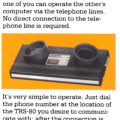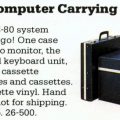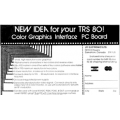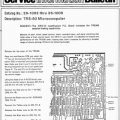Orchestra-90
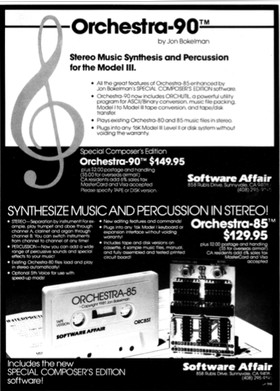
Orchestra-90 advertisement from the February 1982 issue of 80 Microcomputing
Orchestra-90, also known as Orch-90, was a popular hardware sound add-on for the TRS-80 Model III and Model 4, and later the Color Computer. It was created and sold by Software Affair of Sunnyvale (originally Santa Clara), California, along with Orchestra-85, the equivalent add-on for the TRS-80 Model I. It became more popular when Radio Shack began selling a licensed version of Orchestra-90 in 1984. At its peak of popularity, there were over a thousand song files available from CompuServe, Delphi, and BBS’s around the world.
Orchestra-80
Both Orchestra-90 and Orchestra-85 were enhanced versions of Software Affair’s earlier Orchestra-80. Orchestra-85 (the Model I version) was introduced in 1981 for $129.95. Orchestra-90 (the Model III version) followed a few months later for $149.95. Users who wanted to upgrade the Orchestra-80 could send their unit to Software Affair and pay $69.95 (plus $2.00 for shipping and handling) to exchange it for an Orchestra-85.
Like Orchestra-80, both Orchestra-90 and Orchestra-85 were designed by Jon Bokelman. But unlike Orchestra-80, both models could create true stereo sound. They plugged directly into the Model I or Model III expansion bus and provided RCA phono jacks for direct connection to a home stereo system.
Both models came with Jon Bokelman’s “Special Composer’s Edition” software. It could synthesize four voices (instead of three), plus an optional fifth voice on computers with a speed-up modification. In addition to Orchestra-80’s four instruments (clarinet, oboe, pipe organ, and trumpet), the new software added a violin and a percussion effect.
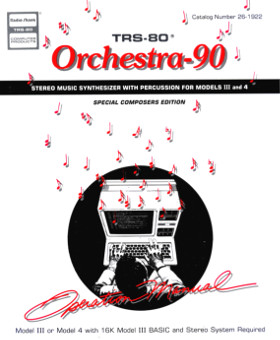
Cover of the Orchestra-90 manual
The Radio Shack Orchestra-90
Radio Shack introduced their licensed version of Orchestra-90 (catalog number 26-1922) in 1984. It cost $79.95, but was otherwise identical to the model Software Affair had sold directly. Here is a description from a Radio Shack catalog:
Create highly sophisticated electronic music and sound effects. Both musicians and non-musicians can compose in six octave ranges in up to five voices. Transcribe sheet music.
The Radio Shack Orchestra-90 was for the Model III and Model 4 only; Radio Shack never sold Orchestra-85 for the Model I. Bryan Eggers, the president of Software Affair, wrote a popular column called “Musical Notes” about the Orchestra-90 for the TRS-80 Microcomputer News.
Radio Shack’s version of Orchestra-90 for the Color Computer, the Orchestra-90 CC (catalog number 26-3143), was introduced in 1985. Like the Model III/4 version, it cost $79.95. The Orchestra-90 CC was a Program Pak that plugged directly into the Color Computer. The built-in software worked similarly to the Model III/4 version, but supported up to five voices by default. Although it was intended to be connected to a home stereo, the Orchestra-90 CC could also play through a television (but with only monophonic sound).
According to Bryan Eggers, Radio Shack had approved plans for Orchestra-1000, a “16-voice stereo PC music synthesizer with MIDI” for their MS-DOS compatible Tandy 1000 computers. Unfortunately, that project was never developed.
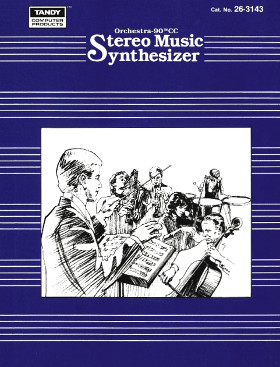
Cover of the Orchestra-90 for the Color Computer manual
Music
The Model III/4 version of Orchestra-90 included four short musical pieces to demonstrate the system:
- “Gypsy Rondo” by Joseph Haydn
- “Entry of the Gladiators” by Julius Fučík.
- “Csárdás” by Vittorio Monti
- “Camptown Races” by Stephen Foster
The Orchestra-90 CC contained “The William Tell Overture” by Gioachino Rossini for its demonstration music.
Radio Shack stores often had demonstration Orchestra-90 units playing music from a menu.
Software Affair sold two volumes of a Orchestra-85/90 classical music collection called Greatest Hits. Volume I and II cost $10.00 individually on cassette, or both volumes together cost $20.00 on disk. The two collections featured 22 pieces of classical music (in stereo), including
- “Hungarian Rhapsody No. 2” by Franz Liszt
- “Turkish March” by Ludwig van Beethoven
- “Anitra’s Dance,” “March of the Dwarfs,” and “In the Hall of the Mountain King” by Edvard Grieg
- “March,” “Dance of the Reed Pipes,” and “Dance of the Super Plum Fairy” by Pyotr Ilyich Tchaikovsky
But the biggest sources of Orchestra-90 files were through online services. Compuserve had a forum for Orchestra-90 music (Go HOM-13) with hundreds of files, as did Delphi. Many BBS’s had huge libraries of Orchestra-90 files. Many of these pieces were classical, but versions of popular music (of the time) were also common. Many of these transcriptions were expertly done.
Computer News 80 probably had the largest collection of Orchestra-90 files. Their Orchestra-90 song collection, part of their File Cabinet public domain disk catalog, contained over 1,500 files.
Symphony 90
Orchestra-90 made its final appearance in a Radio Shack catalog in 1987. Orchestra-90 units became very difficult to find after that. However, there was still interest in Orchestra-90, and song files were still widely available on BBS’s and through public domain disk services.
In 1991, Computer News 80 introduced Symphony 90. With hardware designed by Dick Houston and software by David Goben, Symphony 90 was compatible with the Orchestra-90 and provided a way to continue to play its music files. Computer News 80 sold Symphony 90 until 1996.
